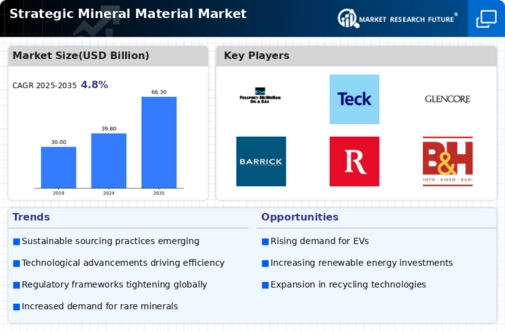Government Policies and Regulations
Government policies and regulations play a pivotal role in shaping the Strategic Mineral Material Market. Many countries are implementing stricter regulations to ensure responsible sourcing and environmental protection. For example, the introduction of tax incentives for companies that invest in sustainable mining practices is becoming more common. Additionally, trade policies that promote domestic production of strategic minerals are emerging, as nations seek to reduce dependency on imports. In 2025, it is anticipated that regulatory frameworks will continue to evolve, potentially increasing the market size of strategic minerals by 10 percent. This regulatory landscape influences investment decisions and operational strategies within the Strategic Mineral Material Market.
Rising Demand for Electric Vehicles
The increasing adoption of electric vehicles (EVs) is driving the Strategic Mineral Material Market. As governments and consumers prioritize sustainability, the demand for lithium, cobalt, and nickel, essential components in EV batteries, has surged. In 2025, the market for lithium alone is projected to reach approximately 60 billion USD, reflecting a compound annual growth rate of over 20 percent. This trend indicates a robust growth trajectory for the Strategic Mineral Material Market, as manufacturers seek to secure reliable sources of these critical minerals to meet production targets. Furthermore, the shift towards renewable energy sources, such as solar and wind, which also require strategic minerals for energy storage solutions, further amplifies this demand.
Technological Innovations in Mining
Technological advancements in mining techniques are reshaping the Strategic Mineral Material Market. Innovations such as automated mining equipment, advanced geological modeling, and real-time data analytics enhance efficiency and reduce operational costs. For instance, the implementation of artificial intelligence in mineral exploration has the potential to increase the discovery rates of strategic minerals. As of 2025, the market for mining technology is expected to exceed 15 billion USD, indicating a significant investment in improving extraction processes. These advancements not only optimize resource recovery but also minimize environmental impacts, aligning with the growing emphasis on sustainable practices within the Strategic Mineral Material Market.
Growing Focus on Renewable Energy Technologies
The transition towards renewable energy technologies is significantly impacting the Strategic Mineral Material Market. As countries commit to reducing carbon emissions, the demand for minerals such as rare earth elements, which are crucial for wind turbines and solar panels, is expected to rise. In 2025, the market for rare earth elements is projected to reach 20 billion USD, driven by the increasing deployment of renewable energy systems. This shift not only enhances energy security but also creates opportunities for companies involved in the extraction and processing of these strategic minerals. The emphasis on clean energy solutions is likely to sustain growth in the Strategic Mineral Material Market for years to come.
Increased Investment in Recycling Technologies
The rising emphasis on sustainability has led to increased investment in recycling technologies within the Strategic Mineral Material Market. As the demand for strategic minerals escalates, recycling offers a viable solution to mitigate supply chain risks and reduce environmental impacts. In 2025, the market for recycled materials is expected to grow by 15 percent, reflecting a shift towards circular economy practices. Companies are increasingly focusing on developing efficient recycling processes for lithium-ion batteries and other electronic waste, which contain valuable strategic minerals. This trend not only conserves natural resources but also aligns with global sustainability goals, thereby enhancing the resilience of the Strategic Mineral Material Market.

















Leave a Comment